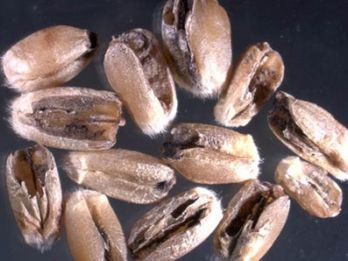Karnal bunt
Karnal bunt (Tilletia indica) is a fungus affecting grains of wheat, durum, and triticale – a hybrid of wheat and rye.
Background
It is not present in Australia, but is found in the USA, Mexico, India, Afghanistan, Pakistan and parts of Nepal and Iraq.
The spores can survive and spread via grain, soil, and cereal trash. They are light and long-lived, easily moved between paddocks by wind, water, soil, and on machinery.
Karnal bunt is most likely to enter Australia either on diseased grain or as spores on the clothing of travellers. Anyone travelling to overseas farms must thoroughly wash all clothing before returning.
Seed imports to Australia should go through appropriate quarantine facilities and all suspect samples must be reported to Biosecurity SA immediately.
Impacts
If introduced into Australia, karnal bunt would be almost impossible to get rid of as its spores can live in the soil for over 5 years until conditions are cool and wet, aiding their growth.
This fungus could severely disrupt the Australian wheat export and international trade, having a major economic impact on the agricultural industry.
Stored grain must be checked frequently for unusual symptoms. Karnal bunt has similar symptoms to:
- common bunt – causing black spores and a rotten smell, however this affects entire heads and seeds of the cereal plant, rather than smaller portions
- loose smut – converting grain seeds and flowering parts to masses of black spores
- flag smut – affecting the leaves
- black point – causing a dark discolouration at the ends and crease of wheat and barley seeds, but this does not produce spores.
Identification
Karnal bunt is not easily detected prior to harvest as usually only a few seeds in each head are affected.
The fungus is easily seen in harvested grain, ranging in symptoms from pinpoint sized spots to thick, black spore masses running the length of the groove in the grain. Only part of each grain is affected, but occasionally the whole seed is blackened and appears sooty.
Infected parts of each grain will crush easily between the fingers, producing a black powder. Often the grain has a rotten fish smell.


